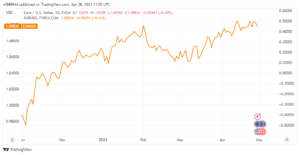EURUSD reversed course and fell below 1.1000.
The EURUSD lost traction and fell below 1.1000 on the final trading day of April, weighed down by broad-based US Dollar (USD) gains. The pair is closing in on the important 1.0970/1.0950 support region. And more losses are possible if buyers fail to defend those levels.
The US economy expanded by 1.1% year on year in the first quarter, missing the market’s estimate of 2% growth. By a significant margin, according to figures released on Thursday.
Nonetheless, the USD held its ground as the report’s underlying details indicated healthy consumer activity and strong inflation during the period. Early Friday, the USD continued to gain strength on risk aversion, causing the EURUSD to fall. Meanwhile, data released on Friday revealed that the German economy contracted at an annual rate of 0.1% in the first quarter. While the Eurozone economy grew by 1.3%, a sharp decrease from 1.8% in the fourth quarter of 2022. These figures appear to be placing extra pressure on the Euro.
The US Dollar continues to strengthen ahead of important data releases.
The US Bureau of Economic Analysis (BEA) will issue the Personal Consumption Expenditures (PCE) Price Index data for March, along with Personal Spending and Personal Income numbers. In the second half of the day. After seeing the details of the first-quarter GDP report. These data are unlikely to give anything new.
The Employment Cost Index (ECI) for the first quarter will also be included on the US economic calendar. The US Federal Reserve is largely expected to boost interest rates. In March, the Fed raised its policy rate by 25 basis points (bps). Following the release of the GDP data, the probability of a rate cut in September fell to 40% from 60% a week ago. A stronger-than-expected gain in the ECI might raise hopes that the Fed would postpone its policy turn, boosting the USD and vice versa.
It’s worth noting that inter-market correlations may diminish later in the day, with month-end flows potentially causing huge swings in key pairings.
Technical Outlook
The 100-period SMA and the Fibonacci 23.6% retracement of the most recent rally offer a sturdy support region at 1.0950/1.0970. If the pair goes below that level and begins to use it as support. It may continue its downward correction below 1.0900/1.0880 (psychological level, 200-period SMA).

On the plus side, sellers may get wary if EURUSD reclaims and stabilizes at 1.1000 (psychological level, static level, 50-period SMA).
In that scenario, the next resistance levels might be 1.1050 (static level) and 1.1070 (end-point of the most recent rally).








